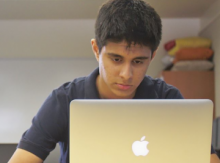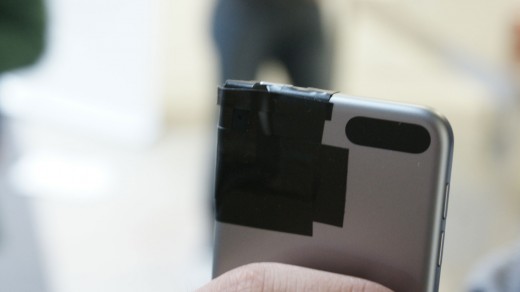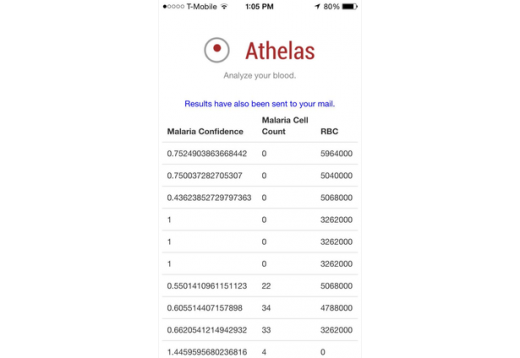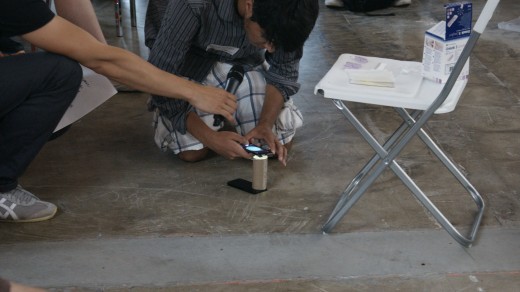
Tanay Tandon is the 17-year-old founder of Athelas, a blood-testing kit for smartphones that is designed to diagnose malaria.
For more than two centuries, cell morphology – or the practice of viewing/analyzing a person’s blood – has been the primary way to approach medicine. The process is generally long and expensive: go to the doctor, get a sample taken, wait for a couple of days for a trained professional to analyze the blood, and then receive your report. Athelas changes all that.
In short – a malaria test that requires no expertise, takes a few seconds, and costs next to nothing. All on a smartphone – holding potential to save thousands of lives.
We first reported on Athelas earlier this month when it won Y Combinator’s first ever hackathon, earning Tandon a chance to interview for a place on the well-respected accelerator program. We caught up with him to find out more about his creation and what’s next.
TNW: What is Athelas?
 Tandon: Athelas is a low-cost microscope lens attachment for smartphones, coupled with a set of backend algorithms for computer vision based malaria detection.
Tandon: Athelas is a low-cost microscope lens attachment for smartphones, coupled with a set of backend algorithms for computer vision based malaria detection.
Using machine learning I was able to put together a set of template-matching and edge-detection approaches for cell-counting and classification. Currently I’m pursuing the work in a more research-oriented fashion, validating the algorithm accuracy as well as testing the microscope attachment on a variety of blood smears and diseased tissue.
The ultimate goal is to be able to detect malaria in blood samples within seconds, as well as eventually train the algorithms to identify a variety of other diseases and conditions.
TNW: What problem are you solving? Is your solution disruptive?
Tandon: Malaria and related blood-based diseases plague much of the world’s rural areas. Unfortunately, high-cost morphology equipment and trained cell morphologists are not available on demand in these areas. Athelas conducts automated blood analysis through computer vision, and brings the microscope down to a low-cost ($5 dollars in production estimates, as opposed to the current $600-$700 setups) system attached to a smartphone.
More research is currently being conducted to boost the accuracies as well as make a smaller more efficient lens attachment.
Athelas prototype on an iPod touch
TNW: Lab tests are highly regulated to ensure the correct results are delivered. The threat of false positives, or incorrect results might be a concern for pharma business. How accurate is Athelas?
Tandon: In terms of accuracy, the score from cross-validation training data is returning between .9 – .95 for cell identification and counts. However, this score is from the training data which consists of a higher resolution images and data than live data. For live blood samples (blood smears images taken directly from the smartphone camera attachment) the accuracy is currently in the range of .7-.75. This drop is due to the lower resolution and blurred images from the microscope.
Over the next few months, the main goal is to incorporate some sort of low-cost staining procedure, as well as multi-fusion image stitching algorithms to boost these numbers to more accurate ranges, comparable to the .9-.95 from training data.
TNW: How do you plan to commercialize Athelas?
Tandon: The first step will be to build out a viable, low-cost version of Athelas for deployment in rural areas. Initially, the focus will be heavily on a few sets of diseases including Malaria and blood-borne pathogens. Once the first version of Athelas is in use with rich datasets being collected, it would likely be best to commercialize Athelas to hospitals and related medical providers.
Athelas being demonstrated at Y Combinator’s hackathon
TNW: What does the prize from Y Combinator mean to you?
Tandon: The prize from Y Combinator means a lot – for one, it was a good validation of the importance on working on humanitarian and medical problems. Second, it shows that the interest in the field of biomedical is growing, and has encouraged me to work on more problems just like Athelas in the future.
The goal for the next couple months will be to get a good validation study in, and build a 3D-printed version of the microscope for simpler production and usage.
TNW: Who is Tanay? Tell us something about your plans.
Tandon: I’m currently a high school senior at Cupertino High. I love working on interesting computer science problems, and my previous experience is in machine learning and natural language processing with the startup I founded, Clipped.
I strongly believe that artificial intelligence and research can be used to drive innovative changes in society, and my goal as I enter college and the workforce will be to continue working on products such as Athelas that can enact positive changes through the power of computer science. In the near future, I will be readying a production-ready model for Athelas and presenting it at the upcoming Y Combinator interview.
TNW: Any tips for starting entrepreneurs from your side?
Tandon: From my previous experience with Clipped, the biggest lesson I learned was that ideas are cheap, but execution is key. In other words –it’s very easy to come up with that initial, seemingly game-changing idea, but the importance lies in building out the first version and getting users to try it out.
As long as the focus is on building prototypes, failing fast with those prototypes, and quickly coming out with the next version, then the creative juices will continue to flow – thus allowing innovative products in the long-run.
Don’t miss: Teenage cancer pioneer talks paywalls
Top image credit: AFP/Getty Images
Get the TNW newsletter
Get the most important tech news in your inbox each week.








